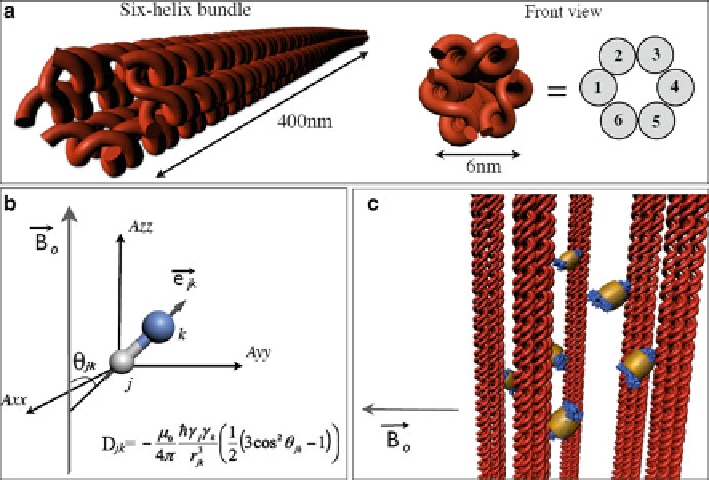Biomedical Engineering Reference
In-Depth Information
Fig. 16.1
DNA-nanotubes design overview. (
a
) Model of the 800-nm-long six-helix bundle
heterodimer.
Right
, perpendicular view of the helical axis of the six-helix bundle design; helices
1
-
6
are labeled.
Left
, view along the helical axis. (
b
)RDCs(D
jk
) between spins j and k provide
long-range constraints on the average orientation (
) of the internuclear bond vector relative to
the applied magnetic field. (
c
) Schematic representation of the six-helix bundles nanotubes liquid
crystals oriented in the magnetic field, simulating weak ordering of membrane protein (
blue
)in
alignment media (Color figure online)
‚
for existing drugs [
15
-
17
]. In spite of the importance of integral membrane proteins
(IMPs), structural biology analysis of this class of proteins remains underdeveloped.
As of the start of the year 2012, the number of structures of unique membrane
proteins deposited into the RCSB Protein Data Bank was a mere 328 (out of over
80,000 protein structures in the data bank), with the large majority determined
through crystallography. However, crystallization of an intact membrane protein
complete with all the relevant functional domains has proven to be extremely
challenging, likely due to the complexity and dynamic nature of membrane proteins.
This, combined with the extreme hydrophobic nature of many classes of IMPs, has
made them extraordinarily difficult to crystallize. Therefore, major advancements
in crystallographic studies of membrane proteins over the past decades have been
limited to understanding the mechanisms of receptor-ligand recognition and the
biochemical consequences of such encounters. As a result, advances in solution-
state NMR spectroscopy have made itself an increasingly more attractive alternative
for studying the structure and dynamics of IMPs [
18
-
23
]. Achieving high-resolution
NMR spectra for any given membrane protein is a prerequisite to further process
sequence-specific resonance assignment of its signals and to perform structure

Search WWH ::

Custom Search